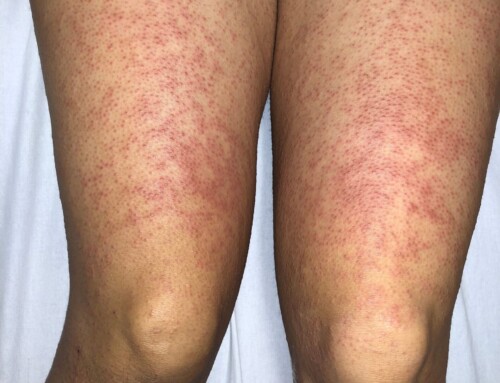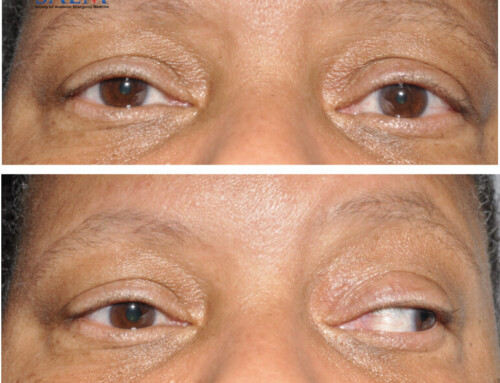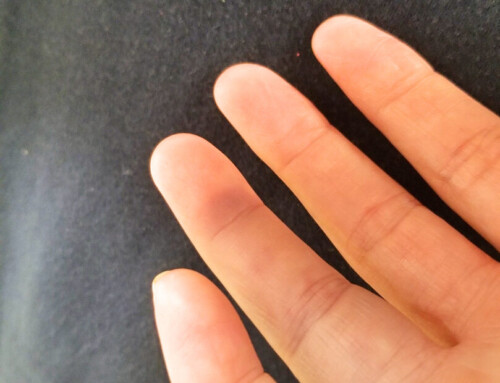
A 33-year-old male presented to the emergency department with a diffuse pruritic rash that appeared several days after starting Trimethoprim/Sulfamethoxazole (TMP-SMX) for a dental infection. Initially beginning on the torso and low back, the rash spread to the palms, soles, and genitalia. Progression stopped after discontinuing TMP-SMX. He conveyed a remote history of a similar rash following use of an unknown medication, and noted that several of the current lesions arose at the same location as previous.
Skin: Widely distributed violaceous, non-blanching patches with a dusky center. Lesions ranged from 3 cm to 10 cm, and included palms and soles. There was no mucosal involvement.
Non-contributory
Fixed drug eruption (FDE). FDE is an uncommon, potentially life-threatening CD8+ T-helper cell-mediated hypersensitivity reaction to certain drugs, commonly NSAIDs, antibiotics, and antiepileptic [1].
Skin findings typically arise within two days of exposure and then more rapidly with subsequent exposures [2]. Characteristically, recurrent lesions appear at the same sites as prior lesions (hence “fixed”) but may arise in additional locations. The rash is classically divided into two phases: an acute phase of pruritic violaceous patches and plaques with central duskiness, followed by a residual phase of hyperpigmentation that can last several months. The sulfonamide moiety of TMP-SMX is a common cause of FDE [3]. Management of FDE anchors on identification and discontinuation of the causative agent. The majority of cases involve five or fewer lesions, however generalized or bullous cases (> 10% total body surface area, or involvement of 3 or more anatomic sites) [1], may require aggressive wound care and carry a mortality rate up to 22% [4]. Topical or systemic steroids are common adjuncts and there is limited evidence suggesting the utility of systemic cyclosporine for severe cases [1]. Patients need to be carefully advised on the risks of specific medication use and can expect a gradual resolution of lesions over the coming months.
Take-Home Points
- FDE is a potentially life-threatening hypersensitivity reaction to certain drugs.
- Recurrent lesions in similar distribution is a hallmark of FDE. Avoidance of the causative agent is the mainstay of management.
- Anderson HJ, Lee JB. A Review of Fixed Drug Eruption with a Special Focus on Generalized Bullous Fixed Drug Eruption. Medicina (Kaunas). 2021 Sep 1;57(9):925. doi: 10.3390/medicina57090925. PMID: 34577848; PMCID: PMC8468217.
- Flowers H, Brodell R, Brents M, Wyatt JP. Fixed drug eruptions: presentation, diagnosis, and management. South Med J. 2014 Nov;107(11):724-7. doi: 10.14423/SMJ.0000000000000195. PMID: 25365443.
- Chow TG, Khan DA. Sulfonamide Hypersensitivity. Clin Rev Allergy Immunol. 2022 Jun;62(3):400-412. doi: 10.1007/s12016-021-08872-3. Epub 2021 Jul 1. PMID: 34212341
- Lipowicz S, Sekula P, Ingen-Housz-Oro S, Liss Y, Sassolas B, Dunant A, Roujeau JC, Mockenhaupt M. Prognosis of generalized bullous fixed drug eruption: comparison with Stevens-Johnson syndrome and toxic epidermal necrolysis. Br J Dermatol. 2013 Apr;168(4):726-32. doi: 10.1111/bjd.12133. Epub 2013 Feb 16. PMID: 23413807.
Copyright
Images and cases from the Society of Academic Emergency Medicine (SAEM) Clinical Images Exhibit at the 2023 SAEM Annual Meeting | Copyrighted by SAEM 2023 – all rights reserved. View other cases from this Clinical Image Series on ALiEM.
Alex Clos, MD
Boston Medical Center
Latest posts by Alex Clos, MD (see all)
- SAEM Clinical Images Series: Man with a Recurrent Rash - November 10, 2023

Andrew Mittelman, MD

Latest posts by Andrew Mittelman, MD (see all)
- SAEM Clinical Images Series: Bulge in the Belly - December 8, 2023
- SAEM Clinical Images Series: Man with a Recurrent Rash - November 10, 2023
- SAEM Clinical Images Series: Wolf in Sheep’s Clothing - November 6, 2023





